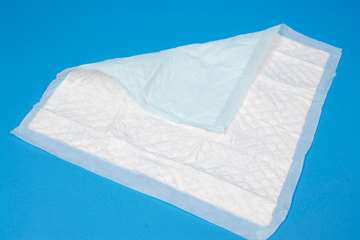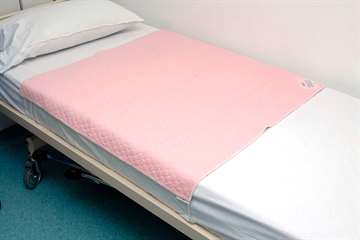Disposable underpads
Disposable underpads are made up of:
- a non-woven top sheet that is intended to allow urine to pass through
- a thin absorbent layer
- a plastic waterproof backing
Some also have “tuck in wings” intended to hold them in place. They are usually only available in one level of absorbency, although absorbency may vary between brands.
They come in different sizes, but most are at least 30cm x 60cm (24” x 36”).
7
Disposable bed padHow well do they work?
Disposable underpads are seldom used for managing incontinence on their own and most research about their performance is old. 1234. They are more useful for protecting furniture against leaks from other products such as body-worn pads or during procedures such as changing other products or using bedpans or urinals.
Disadvantages of disposable underpads
- They are thin and made from lightweight materials so can become folded and move out of position. This means that the underpad may not be in the correct position to contain leakage and folds could potentially cause sore skin.
- They are generally not absorbent enough to be used as sole protection for anything other than very light bladder leakage.
- If used as the only absorbent product they require clothes to be pulled up around the waist or removed. This is generally considered to be unacceptable for dignity.
- They are not very discreet and when placed on a chair they show the user to be incontinent.
- They are non-sterile items often made from recycled paper and there have been concerns that they may present a risk of infection.5678 However, this is thought unlikely to be a health problem unless you have reduced immunity, for example, during chemotherapy.9
Where can I get disposable underpads?
Many types are available through retail outlets such as pharmacies and supermarkets, the internet or direct from suppliers. Not all products are available worldwide. See below for links to suppliers and products in your part of the world.
Washable underpads
Washable underpads are large, absorbent reusable pads designed to absorb bladder leakage and protect bedding or other furniture. Most are made up of:
- a top surface fabric (usually polyester) that allows urine to pass through while keeping the skin dry
- an absorbent core made from felted or woven fibres
- a waterproof backing
Some washable underpads do not have a waterproof backing and require a separate waterproof sheet placed underneath them.
Most washable bedpads are designed to cover the mid portion of a single bed, and are available with and without tuck-in wings or anti-friction backing to prevent them moving around in the bed. Bespoke sizes can be made to order, for example, for a double bed.
Washable chair pads are smaller for use on chairs. They are available in different colours and patterns that are intended to be aesthetically pleasing and to coordinate with soft furnishings. Some types have a quilted top sheet. Many have a special non-slip waterproof backing which makes them less likely to move on the chair and helps to prevent urine leaking onto upholstery.
3
Washable bed pad with integral waterproof backing and tuck in flapsHow well do they work?
Washable underpads are seldom used for managing incontinence on their own, but they are useful for protecting beds and chairs against occasional leaks from other products such as body-worn pads, or when using a urinal or bedpan.
Washable bedpads can be an alternative to wearing body-worn pads or other products, especially for someone who has only light and occasional bladder leakage or for people who try to remove body-worn pads due to confusion. People who experience bowel leakage will require a body-worn product.
Older research evidence reported differences in absorbency and effect on skin between makes of washable underpad.1011 However, there has been no research on washable underpads that are currently available, and these may perform differently from the older products.
Although washable products may be expensive to purchase initially, used over time they may be more economical than disposable products.121314
Disadvantages of washable underpads
- Washable absorbent products tend to be less absorbent than disposable products of similar size and thickness, so washable underpads may be less effective than disposable ones.
- When placed on a chair, underpads show the user to be incontinent, which is often considered to be unacceptable for dignity.
- When washable underpads are used as an alternative to body-worn products, for example in bed, the user must be naked from the waist down so that urine is absorbed directly by the pad without wetting clothing. Some people find this unacceptable.
- In nursing homes, washable underpads are commonly used by multiple patients (in the same way as bed linen) and concerns have been expressed about cross-infection.
Washable underpads can be heavy when wet. They can take a long time to air dry and are a large conspicuous product. They can be tumble dried but this can be expensive.
Those with a built-in waterproof layer take longer to dry than those without.
- Washable underpads can be expensive to buy and you may need several to cope with laundry turnaround. However, they can become cost effective if used repeatedly over long periods.
Laundering washable underpads
Washable underpads are laundered in the same way as body-worn washable pads. Generally they are washed much like normal laundry, following manufacturer’s instructions. It is advisable not to use fabric conditioner as this can reduce absorbency of some products. Click here for more information.
When used in a nursing home, it is important that they are washed at higher temperatures, which ensures pathogenic organisms are destroyed and makes the risk of cross-infection very low.16
Where can I get large washable pads?
Many types are available through retail outlets such as pharmacies and supermarkets, the internet or direct from suppliers. Not all products are available worldwide. See below for links to suppliers and products in your part of the world.
Waterproof bedding
11
Waterproof mattress coverWaterproof mattress covers, pillow covers, duvet covers, wipe-clean duvets and sleeping bag liners are available in a range of sizes and materials. These products do not have any absorbent capacity and are designed only to provide waterproof protection for the mattress and bedding.
Cheaper products are made from plastic. These can make the user feel hot and sweaty, can be noisy, and can deteriorate quickly with repeated washing and drying. Better quality products are made from fabrics with a waterproof coating or from several layers of fabrics (sometimes quilted) with an internal waterproof membrane, and are designed to be more comfortable, softer, quieter and more discreet.
They can be used as back-up protection against leakage from body-worn pads or other products. People who experience only very light or occasional bladder leakage when asleep might use them as their main protection, with or without an absorbent bed pad. Some only use them when away from home for reassurance.
How much does waterproof bedding cost and where can I buy it?
Waterproof mattress protectors are available in many mainstream retail outlets as well as in more specialised outlets and can be bought online. Less common items such as duvet covers and sleeping bag liners can be bought through specialised suppliers and online. The cost of waterproof bedding varies according to the design and which country you live in, so it is not possible to give an exact price range. See below for links to suppliers and products in your part of the world.